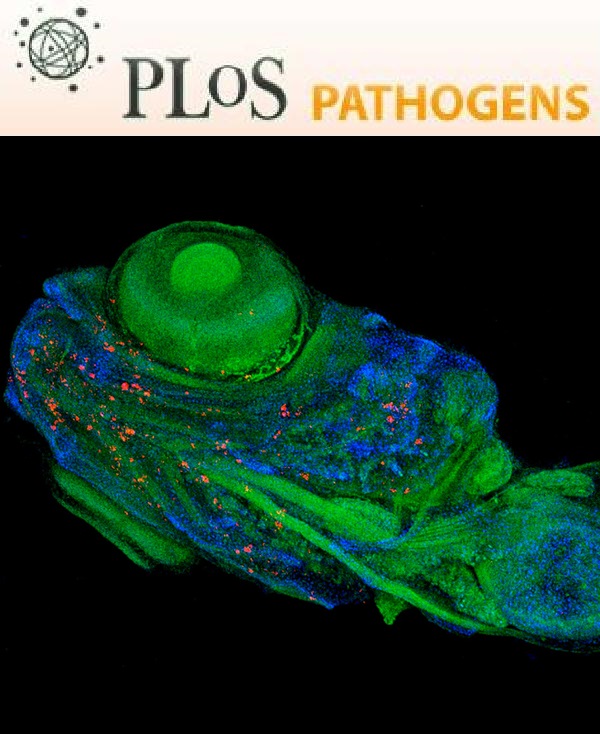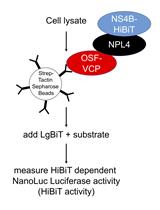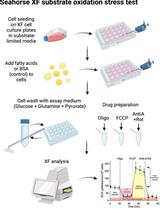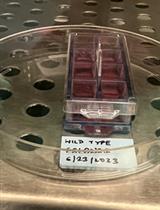- EN - English
- CN - 中文
Neutral Red Assay for Murine Norovirus Replication and Detection in a Mouse
采用中性红试验法进行小鼠诺如病毒增殖和检测
发布: 2013年04月05日第3卷第7期 DOI: 10.21769/BioProtoc.415 浏览次数: 15528
Abstract
Neutral red (NR) is a dye that must be actively imported into the cell, and, therefore, the dye has been used for decades to selectively stain living cells. In addition, NR can also be incorporated into virus particles, although the mechanism behind this is poorly understood. Once encapsulated into the virion, NR, a light sensitive dye, can be photoactivated to inactivate the virus. The proposed mechanism explaining this observation is that activation of NR allows the dye to cross-link viral genome to viral capsid and thus preventing viral uncoating and infection. To study the early events of murine norovirus (MNV)-host interaction, light-sensitive NR-containing MNV is used to distinguish between input virus (i.e., NR-containing virus) and replicated virus (i.e., NR-free virus). This protocol describes the incorporation of NR into MNV capsids and the use of these virions for detection of viral replication in a mouse and in tissue culture by standard plaque assay. The same technique is also used for study of poliovirus replication (1-3). Thus, there is the potential that this technique can be used for additional non-enveloped viruses. However, this has to be tested on a case-by-case basis as unpublished data on feline calicivirus suggests not all viruses may be able to stably incorporate NR into their capsid (J. Parker, personal communication).
Background
Materials and Reagents
- Neutral red 0.33% solution (Sigma-Aldrich, catalog number: N2889 )
- DMEM/ High glucose (Hyclone, catalog number: SH30243.02 )
- 2x MEM (Life Technologies, Gibco®, catalog number: 11935 )
- 100x Penicillin and streptomycin (Hyclone, catalog number: SV30010 )
- 100x Non-essential amino acids (Hyclone, catalog number: SH30238.01 )
- 1 M HEPES (Hyclone, catalog number: SH30237.01 )
- 200 mM (100x) L-glutamine (Hyclone, catalog number: SH30034.01 )
- Fetal bovine serum (FBS) (Life Technologies, Gibco®, catalog number: 10437 or Hyclone, catalog number: SH30070.02 )
- RAW 264.7 cell line (ATCC, catalog number: TIB-71 )
- Murine norovirus (MNV-1; GV/MNV1/2002/USA)
- Sea Plaque Agarose (Lonza, catalog number: 50100 )
- Aluminum foil
- 1.0 mm Zirconia/Silica beads (BioSpec Products, catalog number: 11079110z )
- Mice (6-8 weeks old Balb/cJ)
- DMEM-10 (see Recipes)
- DMEM-5 (see Recipes)
- 2x MEM media (500 ml) (see Recipes)
- SeaPlaque agarose (see Recipes)
- 1:1 ratio of molten media (see Recipes)
Equipment
- 175 cm2 flask (Corning, catalog number: 3292 )
- Model 35 Speed Rocker (Labnet, catalog number: S2035 )
- Tissue culture incubator (Sanyo, catalog number: MCO-36M )
- Magna Lyser Bead beater (F. Hoffmann-La Roche, catalog number: 0 3358968001 )
- Photographic safe red light
Procedure
文章信息
版权信息
© 2013 The Authors; exclusive licensee Bio-protocol LLC.
如何引用
Readers should cite both the Bio-protocol article and the original research article where this protocol was used:
- González-Hernández, M. B., Perry, J. W. and Wobus, C. E. (2013). Neutral Red Assay for Murine Norovirus Replication and Detection in a Mouse. Bio-protocol 3(7): e415. DOI: 10.21769/BioProtoc.415.
- Perry, J. W., M. Ahmed, K.-O. Chang, N. J. Donato, H. D. Showalter, and C. E. Wobus. 2012. Antiviral activity of a small molecule deubiquitinase inhibitor occurs via induction of the unfolded protein response. PLoS Pathog 8(7): e1002783.
分类
微生物学 > 微生物-宿主相互作用 > 病毒
细胞生物学 > 细胞染色 > 蛋白质
您对这篇实验方法有问题吗?
在此处发布您的问题,我们将邀请本文作者来回答。同时,我们会将您的问题发布到Bio-protocol Exchange,以便寻求社区成员的帮助。
提问指南
+ 问题描述
写下详细的问题描述,包括所有有助于他人回答您问题的信息(例如实验过程、条件和相关图像等)。
Share
Bluesky
X
Copy link















